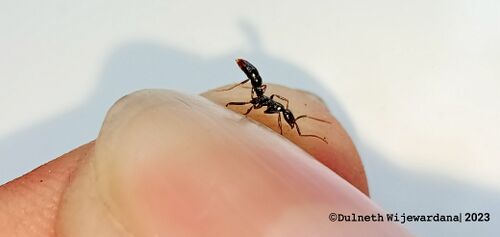Leptogenys peuqueti
| Leptogenys peuqueti | |
|---|---|

| |
| Scientific classification | |
| Kingdom: | Animalia |
| Phylum: | Arthropoda |
| Class: | Insecta |
| Order: | Hymenoptera |
| Family: | Formicidae |
| Subfamily: | Ponerinae |
| Tribe: | Ponerini |
| Genus: | Leptogenys |
| Species group: | chinensis |
| Species: | L. peuqueti |
| Binomial name | |
| Leptogenys peuqueti (André, 1887) | |
| Synonyms | |
| |
Leptogenys peuqueti is the most common Leptogenys recorded from Hong Kong, collected from a wide variety of habitats including forests, shrubland as well as disturbed urban sites. Workers are known to foraging individually but will recruit small numbers of workers to tackle larger prey items (Janssen et al. 1997; MTH pers. obs.). Workers have been noted to feed upon isopods in Hong Kong. Nests have been found within rotting logs, under rocks and within soil (often underneath objects). Colonies are queenless, instead reproducing through gamergates (Ito 1997). One colony collection contained 67 workers, 20 cocoons and four larvae (MTH271), correlating with Ito (1997) who found the number of workers in L. peuqueti colonies to range from 5 and 97. (Hamer et al., 2024)
| At a Glance | • Gamergate |
Photo Gallery
Identification
A member of the Leptogenys chinensis species group.
Hamer et al. (2024) - Leptogenys peuqueti is most similar to Leptogenys grohli and Leptogenys kraepelini within Hong Kong and Macao, being distinguishable from L. grohli by the smooth head dorsum, larger eyes, shorter tubular setae on the anterior clypeal margin, and convex lateral head margins. Leptogenys peuqueti highly resembles L. kraepelini, but lacks the truncated anterior clypeal margin found in L. kraepelini, the posteriorly projecting propodeal lobes and is overall smaller.
Within the wider Indomalayan Leptogenys species, L. peuqueti is most similar to Leptogenys confucii, as well as other members of the L. chinensis group. Leptogenys peuqueti can be differentiated by the smooth head dorsum, meso- and metathorax, and propodeum, as well as its black colour.
Keys including this Species
- Key to Leptogenys of India
- Key to Leptogenys of China
- Key to Oriental Leptogenys
- Keys to Oriental Region Leptogenys chinensis group species
- Key to Leptogenys of Hong Kong
Distribution
Hamer et al. (2024) - A very wide-ranging species in Indomalaya, L. peuqueti is recorded from several Chinese provinces including Fujian, Guangdong, Guangxi, Hainan, Hong Kong Hubei, Hunan, Macao, Yunnan, and Zhejiang (Guénard and Dunn 2012; Xu and He 2015; Janicki et al. 2016; Guénard et al. 2017; Brassard et al. 2021). Other countries include Bangladesh, Bhutan, India (Andaman Islands, Kerala, Meghalaya, Sikkim, and West Bengal), Indonesia (Java), Malaysia (Peninsular and Bornean parts), Myanmar, The Philippines, Singapore, Sri Lanka, and Vietnam (Bakhtiar and Chiang 2010; Janicki et al. 2016; Guénard et al. 2017; Wang et al. 2022). Further sampling effort across the Oriental region will likely produce new country level records of this species (e.g., Cambodia, Laos, Thailand).
Latitudinal Distribution Pattern
Latitudinal Range: 22.675° to 3.698055556°.
| North Temperate |
North Subtropical |
Tropical | South Subtropical |
South Temperate |
- Source: AntMaps
Distribution based on Regional Taxon Lists
Indo-Australian Region: Philippines, Singapore.
Oriental Region: Bangladesh, India (type locality), Myanmar (type locality), Sri Lanka, Vietnam (type locality).
Palaearctic Region: China.
Distribution based on AntMaps
Distribution based on AntWeb specimens
Check data from AntWeb
Countries Occupied
| Number of countries occupied by this species based on AntWiki Regional Taxon Lists. In general, fewer countries occupied indicates a narrower range, while more countries indicates a more widespread species. |

|
Estimated Abundance
| Relative abundance based on number of AntMaps records per species (this species within the purple bar). Fewer records (to the left) indicates a less abundant/encountered species while more records (to the right) indicates more abundant/encountered species. |

|
Biology
Thirteen colonies of L. peuqueti collected had 25.5 ± 22 virgin workers (range 4-88) and 4 ± 3.4 gamergates (range 1-13)(Ito 1997). Three colonies had a single gamergate.
Castes
  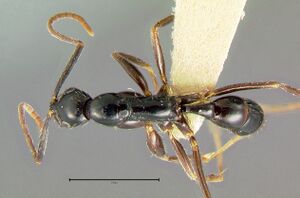 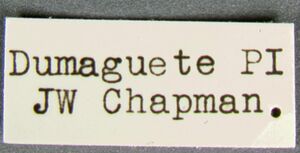
| |
| . | Owned by Museum of Comparative Zoology. |
Images from AntWeb
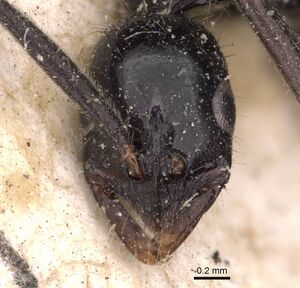  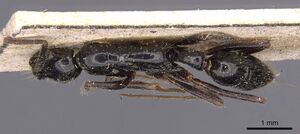 
| |
| Syntype of Leptogenys peuqueti. Worker. Specimen code casent0907380. Photographer Will Ericson, uploaded by California Academy of Sciences. | Owned by MHNG, Geneva, Switzerland. |
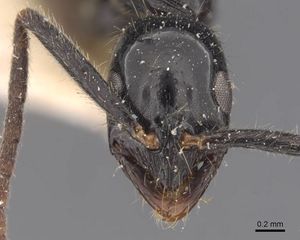   
| |
| Syntype of Leptogenys minchinii. Worker. Specimen code casent0907379. Photographer Will Ericson, uploaded by California Academy of Sciences. | Owned by MHNG, Geneva, Switzerland. |
   
| |
| Syntype of Leptogenys watsoni. Worker. Specimen code casent0907381. Photographer Will Ericson, uploaded by California Academy of Sciences. | Owned by MHNG, Geneva, Switzerland. |
Nomenclature
The following information is derived from Barry Bolton's Online Catalogue of the Ants of the World.
- peuqueti. Lobopelta peuqueti André, 1887: 292 (w.) VIETNAM. Imai, Kubota, et al. 1985: 46 (k.). Combination in Leptogenys: Emery, 1895k: 461. Senior synonym of minchinii: Xu & He, 2015: 145. See also: Bingham, 1903: 71.
- minchinii. Leptogenys (Lobopelta) minchinii Forel, 1900d: 308 (diagnosis in key) (w.) INDIA. Forel, 1900d: 314 (m.); Imai, Baroni Urbani, et al. 1984: 5 (k.). Junior synonym of peuqueti: Xu & He, 2015: 145. See also: Bingham, 1903: 70; Rothney, 1903: 97.
- watsoni. Leptogenys peuqueti r. watsoni Forel, 1900d: 309 (diagnosis in key) (w.) MYANMAR. Raised to species: Bingham, 1903: 72. Junior synonym of peuqueti: Xu & He, 2015: 145.
Description
Karyotype
- See additional details at the Ant Chromosome Database.
 Explore: Show all Karyotype data or Search these data. See also a list of all data tables or learn how data is managed.
Explore: Show all Karyotype data or Search these data. See also a list of all data tables or learn how data is managed.
- n = 26, 2n = 52 (India) (Imai et al., 1984; Mariano et al., 2015) (as Leptogenys minchini).
- n = 27, 2n = 54 (Indonesia) (Imai et al., 1985; Mariano et al., 2015).
References
- André, E. 1887. Description de quelques fourmis nouvelles ou imparfaitement connues. Rev. Entomol. (Caen) 6: 280-298 (page 292, worker described)
- Bingham, C. T. 1903. The fauna of British India, including Ceylon and Burma. Hymenoptera, Vol. II. Ants and Cuckoo-wasps. London: Taylor and Francis, 506 pp. (page 71, see also)
- Dendup, K.C., Dorji, C., Dhadwal, T., Bharti, H., Pfeiffer, M. 2021. A preliminary checklist of ants from Bhutan. Asian Myrmecology 14, e014005 (doi:10.20362/am.014005).
- Dias, R.K.S., Kosgamage, K.R.K.A. 2013. Occurrence and species diversity of ground-dwelling worker ants (Family: Formicidae) in selected lands in the dry zone of Sri Lanka. Journal of Science of the University of Kelaniya Sri Lanka 7: 55-72 (doi:10.4038/josuk.v7i0.6233).
- Dias, R.K.S., Rajapaksa, R.P.K.C. 2017. Geographic records of subfamilies, genera and species of ants (Hymenoptera: Formicidae) in the four climatic zones of Sri Lanka: A review. Journal of Science of the University of Kelaniya Sri Lanka 11, 23-45. (doi:10.4038/josuk.v11i2.7999).
- Emery, C. 1895m. Viaggio di Leonardo Fea in Birmania e regioni vicine. LXIII. Formiche di Birmania del Tenasserim e dei Monti Carin raccolte da L. Fea. Parte II. Ann. Mus. Civ. Stor. Nat. 34[=(2(14): 450-483 (page 461, Combination in Leptogenys)
- General, D.E.M. 2021. A preliminary checklist of the ants (Hymenoptera: Formicidae) of the Mt. Pantaron Range, Bukidnon Province, Mindanao Island, Philippines. Halteres, 12:4-14 (doi:10.5281/ZENODO.5371745).
- Hamer, M.T., Lee, J.H.C., Tse, C.Y.L., Silva, T.S.R., Guénard, B. 2024. The Leptogenys Roger, 1861 (Formicidae, Ponerinae) of Hong Kong SAR with additional records from Guangdong, China. ZooKeys 1202, 169–211 (doi:10.3897/zookeys.1202.120214).
- Imai, H. T.; Kubota, M.; Brown, W. L., Jr.; Ihara, M.; Tohari, M.; Pranata, R. I. 1985. Chromosome observations on tropical ants from Indonesia. Annu. Rep. Natl. Inst. Genet. Jpn. 35: 46-48 (page 46, karyotype described)
- Ito F. 1997. Colony composition and morphological caste differentiation between ergatoid queens and workers in the ponerine ant genus Leptogenys in the Oriental tropics. Ethology Ecology Evolution 9:335–343.
- Mariano, C.S.F., Santos, I.S., Silva, J.G., Costa, M.A., Pompolo, S.G. 2015. Citogenética e evolução do cariótipo em formigas poneromorfas. In: Delabie, J.H.C., Feitosa, R.M., Serrao, J.E., Mariano, C.S.F., Majer, J.D. (eds) As formigas poneromorfas do Brasil, 1st edn. Ilhéus, Brasil, pp 102–125 (doi:10.7476/9788574554419.0010).
- Wang, W.Y., Soh, E.J.Y., Yong, G.W.J., Wong, M.K.L., Benoit Guénard, Economo, E.P., Yamane, S. 2022. Remarkable diversity in a little red dot: a comprehensive checklist of known ant species in Singapore (Hymenoptera: Formicidae) with notes on ecology and taxonomy. Asian Myrmecology 15: e015006 (doi:10.20362/am.015006).
- Xu, Z. 1996b. A taxonomic study of the ant genus Leptogenys (Hymenoptera: Formicidae) in China. J. Yunnan Agric. Univ. 11: 222-227 (page 224, record in China)
- Xu, Z.-H., He, Q.-J. 2015. Taxonomic review of the ponerine ant genus Leptogenys ROGER, 1861 (Hymenoptera: Formicidae) with a key to the Oriental species. Myrmecological News, 21, 137-161.
- Yamane, S., Tanaka, H.O., Hasimoto, Y., Ohashi, M., Meleng, P., Itioka, T. 2021. A list of ants from Lambir Hills National Park and its vicinity, with their biological information: Part II. Subfamilies Leptanillinae, Proceratiinae, Amblyoponinae, Ponerinae, Dorylinae, Dolichoderinae, Ectatomminae and Formicinae. Contributions from the Biological Laboratory, Kyoto University 31, 87–157.
References based on Global Ant Biodiversity Informatics
- André E. 1887. Description de quelques fourmis nouvelles ou imparfaitement connues. Rev. Entomol. (Caen) 6: 280-298.
- Bakhtiar E.Y., and S.L. Chiang. 2010. Leptogenys ants (Hymenoptera: Formicidae: Ponerinae) of Sabah. Serangga 15(1-2): 37-55.
- Bui T.V. 2002. Result of ant survey in Tam Dao National Park. Hoi Nghi Con Trung Hoc Toan Quoc, Ha Noi 495-498.
- Chapman, J. W., and Capco, S. R. 1951. Check list of the ants (Hymenoptera: Formicidae) of Asia. Monogr. Inst. Sci. Technol. Manila 1: 1-327
- Dad J. M., S. A. Akbar, H. Bharti, and A. A. Wachkoo. 2019. Community structure and ant species diversity across select sites ofWestern Ghats, India. Acta Ecologica Sinica 39: 219–228.
- Dias R. K. S. 2002. Current knowledge on ants of Sri Lanka. ANeT Newsletter 4: 17- 21.
- Dias R. K. S. 2006. Current taxonomic status of ants (Hymenoptera: Formicidae) in Sri Lanka. The Fauna of Sri Lanka: 43-52. Bambaradeniya, C.N.B. (Editor), 2006. Fauna of Sri Lanka: Status of Taxonomy, Research and Conservation. The World Conservation Union, Colombo, Sri Lanka & Government of Sri Lanka. viii + 308pp.
- Dias R. K. S. 2013. Diversity and importance of soil-dweeling ants. Proceedings of the National Symposium on Soil Biodiversity, chapt 4, pp 19-22.
- Dias R. K. S., H. P. G. R. C. Ruchirani, K. R. K. A. Kosgamage, and H. A. W. S. Peiris. 2013. Frequency of nest occurrence and nest density of Aneuretus simoni Emery (Sri Lankan Relict Ant) and other ant fauna in an abandoned rubber plantation (Kirikanda Forest) in southwest Sri Lanka. Asian Myrmecology 5: 59-67.
- Dias R. K. S., K. R. K. A. Kosgamage, and H. A. W. S. Peiris. 2012. The Taxonomy and Conservation Status of Ants (Order: Hymenoptera, Family: Formicidae) in Sri Lanka. In: The National Red List 2012 of Sri Lanka; Conservation Status of the Fauna and Flora. Weerakoon, D.K. & S. Wijesundara Eds., Ministry of Environment, Colombo, Sri Lanka. p11-19.
- Dias R. K. S., and K. R. K. Anuradha Kosgamage. 2012. Occurrence and species diversity of ground-dwelling worker ants (Family: Formicidae) in selected lands in the dry zone of Sri Lanka. J. Sci. Univ. Kelaniya 7: 55-72.
- Eguchi K., B. T. Viet, and S. Yamane. 2014. Generic Synopsis of the Formicidae of Vietnam (Insecta: Hymenoptera), Part IICerapachyinae, Aenictinae, Dorylinae, Leptanillinae, Amblyoponinae, Ponerinae, Ectatomminae and Proceratiinae. Zootaxa 3860: 001-046.
- Eguchi K., T. V. Bui, S. Yamane, H. Okido, and K. Ogata. 2004. Ant faunas of Ba Vi and Tam Dao, North Vietnam (Insecta: Hymenoptera: Formicidae). Bull. Inst. Trop. Agr. Kyushu Univ. 27: 77-98.
- Emery C. 1893. Voyage de M. E. Simon à l'île de Ceylan (janvier-février 1892). Formicides. Annales de la Société Entomologique de France 62: 239-258.
- Emery C. 1901. Ameisen gesammelt in Ceylon von Dr. W. Horn 1899. Deutsche Entomologische Zeitschrift 1901: 113-122.
- Emery C. 1911. Hymenoptera. Fam. Formicidae. Subfam. Ponerinae. Genera Insectorum 118: 1-125.
- Fellowes J. R., and D. Dudgeon. 2003. Common ants of lowland forests in Hong Kong, Tropical China. Proceedings of the 2nd ANeT Workshop and Seminar, p. 19-43.
- Forel A. 1900. Les Formicides de l'Empire des Indes et de Ceylan. Part VII. J. Bombay Nat. Hist. Soc. 13: 303-332.
- Forel A. 1905. Ameisen aus Java. Gesammelt von Prof. Karl Kraepelin 1904. Mitt. Naturhist. Mus. Hambg. 22: 1-26.
- Forel A. 1907. Formicides du Musée National Hongrois. Ann. Hist.-Nat. Mus. Natl. Hung. 5: 1-42.
- Forel A. 1909. Études myrmécologiques en 1909. Fourmis de Barbarie et de Ceylan. Nidification des Polyrhachis. Bull. Soc. Vaudoise Sci. Nat. 45: 369-407.
- Guénard B., and R. R. Dunn. 2012. A checklist of the ants of China. Zootaxa 3558: 1-77.
- Helms J. A., S. M. Helms, N. I. Fawzi, Tarjudin, F. Xaverius. 2017. Ant community of an Acacia mangium forest in Indonesian Borneo. Serangga 22(1): 147-159.
- Imai H. T., M. Kubota, W. L. Brown, Jr., M. Ihara, M. Tohari, and R. I. Pranata. 1985. Chromosome observations on tropical ants from Indonesia. Annu. Rep. Natl. Inst. Genet. Jpn. 35: 46-48.
- Ito, F.; Yamane, S.; Eguchi, K.; Noerdjito, W. A.; Kahono, S.; Tsuji, K.; Ohkawara, K.; Yamauchi, K.; Nishida, T.; Nakamura, K. 2001. Ant species diversity in the Bogor Botanic Garden, West Java, Indonesia, with descriptions of two new species of the genus Leptanilla (Hymenoptera, Formicidae). Tropics 10:379-404.
- Kadoorie Farm and Botanic Garden, 2002. Report of Rapid Biodiversity Assessments at Dinghushan Biosphere Reserve, Western Guangdong, 1998 and 2000. South China Forest Biodiversity Survey Report Series (Online Simplified Version): No. 7. KFBG, Hong Kong SAR, ii + 24pp.
- Kadoorie Farm and Botanic Garden, 2003. Report of Rapid Biodiversity Assessments at Shiwandashan National Nature Reserve and National Forest Park, Southwest Guangxi, China, 2000 and 2001. South China Forest Biodiversity Survey Report Series (Online Simplified Version): No. 35. KFBG, Hong Kong SAR, ii + 30 pp.
- Kishimoto-Yamata K., F. Hyodo, M. Matsuoka, Y. Hashimoto, M. Kon, T. Ochi, S. Yamane, R. Ishii, and T. Itioka. 2012. Effects of remnant primary forests on ant and dung beetle species diversity in a secondary forest in Sarawak, Malaysia. Journal of Insect Conservation DOI 10.1007/s10841-012-9544-6
- Leong C. M., S. F. Shiao, and B. Guenard. 2017. Ants in the city, a preliminary checklist of Formicidae (Hymenoptera) in Macau, one of the most heavily urbanized regions of the world. Asian Myrmecology 9: e009014.
- Li Z.h. 2006. List of Chinese Insects. Volume 4. Sun Yat-sen University Press
- Mathew R., and R. N. Tiwari. 2000. Insecta: Hymenoptera: Formicidae. Pp. 251-409 in: Director; Zoological Survey of India (ed.) 2000. Fauna of of Meghalaya. Part 7. [State Fauna Series 4.] Insecta 2000. Calcutta: Zoological Survey of India, 621 pp.
- Menozzi, C. 1932. Formiche dell'Isola di Nias. Misc. Zool. Sumatr. 65: 1-13
- Mohanraj P., M. Ali, and K. Veerakumari. 2010. Formicidae of the Andaman and Nicobar Islands (Indian Ocean: Bay of Bengal). Journal of Insect Science 10: Article 172
- Mohanraj, P., M. Ali and K. Veenakumari. 2010. Formicidae of the Andaman and Nicobar Islands (Indian Ocean: Bay Of Bengal). Journal of Insect Science 10:172.
- Radchenko A. G. 1993. Ants from Vietnam in the collection of the Institute of Zoology, PAS, Warsaw. I. Pseudomyrmicinae, Dorylinae, Ponerinae. Annales Zoologici (Warsaw) 44: 75-82.
- Rizali A., M. M. Bos, D. Buchori, Sk. Yamane, and C. H. Schulze. 2008. Ants in tropical urban habitats: the myrmecofauna in a densely populated area of Bogor, West Java, Indonesia. Hayati Journal of Biosciences 15(2): 77-84.
- Rizali A., M.M. Bos, D. Buchori, Sk. Yamane, C. Hans, and J. Schulze. 2008. Ants in tropical urban habitats: the myrmecofauna in a densely populated area of Bogor, West Java, Indonesia. Hayati Journal of Biosciences 77-84.
- Tiwari R.N., B.G. Kundu, S. Roychowdhury, S.N. Ghosh. 1999. Insecta: Hymenoptera: Formicidae. Pp. 211-294 in: Director; Zoological Survey of India (ed.) 1999. Fauna of West Bengal. Part 8. Insecta (Trichoptera, Thysanoptera, Neuroptera, Hymenoptera and Anoplura). Calcutta: Zoological Survey of India, iv + 442 pp.
- Wheeler W. M. 1921. Chinese ants. Bulletin of the Museum of Comparative Zoology 64: 529-547.
- Wheeler W. M. 1930. A list of the known Chinese ants. Peking Natural History Bulletin 5: 53-81.
- Wheeler W. M., and J. W. Chapman. 1925. The ants of the Philippine Islands. Part I, Dorylinae and Ponerinae. Philipp. J. Sci. 28: 47-73.
- Xu Z. H., and Q. J. He. 2015. Taxonomic review of the ponerine ant genus Leptogenys ROGER, 1861 (Hymenoptera: Formicidae) with a key to the Oriental species. Myrmecological News 21: 137-161.
- Xu Z. 1996. A taxonomic study on the ant genus Leptogenys (Hymenoptera: Formicidae) in China. [In Chinese] Journal of Yunnan Agricultural University 11(4): 222-227
- Zhou S., Y. Chen, Z. Chen, P. Zhou, D. Ban, and M. Huang. 2012. Two new species of the genus Leptogenys from Guangxi, China (Hymenoptera: Formicidae). Sociobiology 59: 885-892.
- Zryanin V. A. 2011. An eco-faunistic review of ants (Hymenoptera: Formicidae). In: Structure and functions of soil communities of a monsoon tropical forest (Cat Tien National Park, southern Vietnam) / A.V. Tiunov (Editor). – M.: KMK Scientific Press. 2011. 277 р.101-124.


